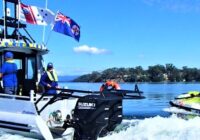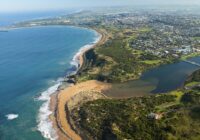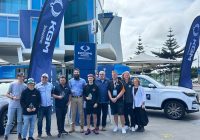ATL Composites supplies the materials to recreate a legendary vessel and an epic adventure.
In a makeshift tin shed in Newcastle, NSW, marine surveyor Mike Smith is building a replica of the legendary Suhaili, the cutting ketch made famous when Robin Knox-Johnston sailed non-stop around the world to win the 1968 Sunday Times Golden Globe Race.
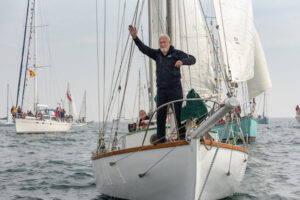
Suhaili Sir Robin Knox-Johnston aboard Suhaili – 50th anniversary of his record setting circumnavigation
“The original was a 32-foot (9.8-metre), nine tonne Bermudan ketch made entirely of teak, very thick 32mm planking and iron fastenings to William Atkin’s ‘ERIC’ plans and based on Norwegian sailing lifeboats by Colin Archer,” explains Mike.
“It was made in Bombay with traditional techniques using bow drills and is very heavy, but very seaworthy.”
Mike is building his own Suhaili for the modern iteration of the Golden Globe Race, revived in 2018 by Don McIntyre, his dedicated team of four and thousands of volunteers.
A 30,000 nautical mile, east-around, solo circumnavigation via the five Great Capes with four rendezvous gates and a deadline date for finishing, the Golden Globe Race starts and finishes in France.
According to the race rules, entrants must be between 32 and 36-feet overall (9.75 to 10.97m) designed prior to 1988 with a full-length keel with rudder attached to their trailing edge.
Competitors are limited to using equipment similar to what was available to Sir Robin in that first race. That means sailing without modern technology or the benefit of satellite-based navigation aids.
Mike has been working on his incarnation of Suhaili for six years so far and was unable to complete the vessel in time to participate in the 2022-23 edition, which departed Les Sables-d’Olonne, France on 4 September 2022.
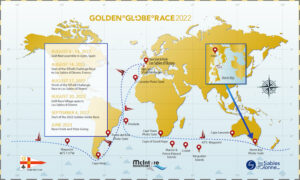
The race runs every four years and Mike has his eye on the 2026 event, but he is aiming to get Suhaili on the water by the end of this year.
“In 2024, I will be testing and optimising her by sailing locally, most likely in offshore races such as the Gosford to Lord Howe Race, maybe circumnavigate New Zealand.
“I need to harden myself up as well as the boat,” he jokes, “And a Trans-Tasman would give me experience of diverse conditions.”
Building a replica is within race rules, and Mike is already well advanced. “I’m building my boat a bit differently,” he says.
“The original Suhaili was a cutter, and very heavy, made of teak and iron. My boat is built of Western Red Cedar, strip planked, and plywood on the bulkheads and decks. It is going to look very different, more modern, with two full-length sails and clean, basic, spartan.”
For the rig, Mike worked with yacht rigging expert, David Lambourne for the best arrangement of his Dacron sails.
“She’s rigged for single-handed sailing. My background is in multihull sailing and I know how important ease of use, strength and reliability can be.”
Equally important, the materials and products he has selected to build Suhaili.
Working with Mac Dalton from ATL Composites, Mike specified 200grm plain weave E-fibreglass, KINETIX 246 TX resin, with a variety of hardeners for laminating, and Techniglue R60, a pre-filled structural adhesive for bonding applications.
“R60 is one of our most popular products and used by professional and amateur builders alike. Available with a choice of hardener speeds, and the thixotropic nature of the adhesive, it provides good gap-filing and hold-up on vertical surfaces,” states Mac.
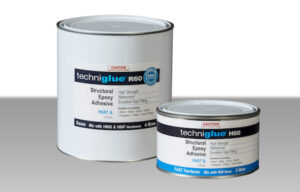
Technirez 2517 a general-purpose epoxy manufactured by ATL Composites was also blended with WEST SYSTEM 413 Microfibre Blend for other bonding applications on the project.
Working late into the evenings and early mornings, most of the weekend, Mike has put the ATL products to the test.
“In Newcastle, we experience a vast range of temperatures,” he says, “from minus two to 42 C, which is very challenging for resins. I chose slow hardeners because I’m working by myself.
“I’ve worked with ATL products for decades at Boatspeed and on other projects. They’re consistent, reliable, user-friendly, they come with accurate instructions, and the team always offers great support. If I order products, they arrive in a day or two, which is fantastic!”
What possessed him to set his sights on competing in what must certainly be the toughest challenge a sailor could embark upon?
“I grew up in Port Elizabeth, South Africa, and in summer we went camping on the Wild Coast. With that pounding surf and distant horizon, I always dreamt of sailing out to sea, way off in the distance to Antarctica. I always wanted to do something crazy like this.”
Though modest about his skills, Mike is a step above the average amateur builder, having worked on many other projects and currently working as a Marine Surveyor and Insurance Assessor.
“It’s taken so long because I can’t throw all my resources at it,” he says. “I work on it four to six hours a day, but I have to work smart and not get tired, or I’ll do something stupid to the boat or myself.
“I’ve got a way to go yet. I want to have it in the water this year which I think is quite achievable.”
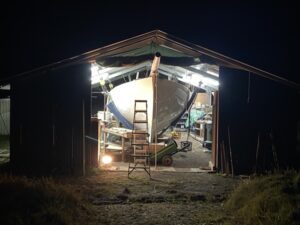
This ambitious labour of love, a project of a lifetime, revives the spirit of adventure and must keep him safe and secure for 30,000 nautical miles in often brutal seas.
“Sailing is a technical challenge as much as it’s a physical challenge. You have your preparation, your planning, your skill and of course, the weather, which we can’t do anything about but navigate through it.
“I will be alone at sea for 200 days, perhaps 250, with just charts and a sextant, and radio weather. I have to think of my strength, physical and mental, my navigation skills and nutrition. I’m currently experimenting with different foods. I love bread, so I have to work out how to bake it onboard.”
Reflecting on the project and the eight years it will take him, Mike says the only thing he would do differently is “build an insulated shed!”





